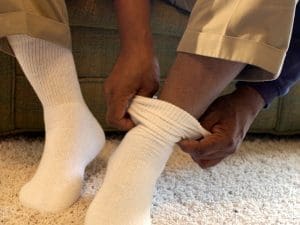
“I can’t stay on my tractor for more than five minutes,” the patient told Rony Gorges, MD. “My legs swell up like balloons. They ache. They hurt. They’re heavy and they’re throbbing.”
Dr. Gorges, one of the cardiovascular experts at University of Michigan Health-West’s Heart & Vascular team, responded, “OK, let’s take a look at your veins.”
“Within a months after treatment, the patient was back on the tractor, happy as can be,” Gorges recalled.
Venous problems affect the legs when damaged veins and valves result in insufficient blood flow back to the heart. The condition is very common: The Society for Vascular Surgery says chronic venous insufficiency (CVI) affects up to 40% of the U.S. population. Some studies estimate it is at least twice as common among women.
In addition to pain and discomfort, it can result in varicose veins and persistent wounds that will not heal. It also can be an indicator of heart failure.
And so, Gorges and his Heart & Vascular colleagues at University of Michigan Health-West want to remind you to pay attention to another part of your body: your legs.
Start a sock routine

The good news is that venous problems can be easy to diagnose, with simple treatment options ranging from exercise to minimally invasive procedures that allow you to return to work the next day. Unfortunately, many are unaware of a problem until it becomes more complicated and difficult to treat.
But there is a simple solution, Gorges said.
“You know, most of us are wearing socks every day,” he said. “So, as you put your socks on, take a look at your legs. Are they more swollen than normal? Do you have sock rings there when you take your socks off in the evening? Push on your tibia, on the shin, and see if there is indentation.”
Gorges said you should make note of any changes – including discoloration, swelling, leg fatigue, visible veins, or a dry feeling to the skin – and discuss them with your primary care provider.
Know the risk factors
Past pregnancies add to the increased prevalence among women. Family history of varicose veins is another factor. Although the condition is more common after age 50, Gorges has treated patients from their 20s into their 90s. People with sedentary jobs or lifestyles are also at greater risk.

“I tell all my patients to set timers on their smartphones or watches at 45-minute intervals,” he said. “When that thing goes off, just get up and move around, get that blood circulating in your legs, and it will help.”
Being overweight can add risk.
“Most people have gained weight during the pandemic,” he said. “That gain of even 10 to 20 pounds can kind of tip you over the edge and can start leading to venous disease that otherwise may have not happened until five, 10 years down the road.”
If the condition goes untreated, it can lead to a chronic tightening and hardening of the skin that makes wound healing difficult, or spontaneous fissures that become skin ulcers and carry risk of serious infection. In fact, Gorges sees many patients when they notice a wound takes months to heal. Fortunately, treating the venous problem often helps restore healing.
Treatment options
Once a venous problem is confirmed with an ultrasound exam, treatment begins with conservative approach, such as elevating the legs while resting, avoiding stationary positions, losing weight, and exercising. Compression socks are another widely used treatment.
If these don’t resolve the problem, the UMH-West Heart & Vascular team has innovative options, such as using a catheter to treat the inside of the veins with heat. A more recent advance applies a medical adhesive inside the vein, redirecting blood flow to deeper, healthier veins. Varicose veins can be removed through incisions as tiny as the tip of a ball-point pen.